AMD Kaveri Review: A8-7600 and A10-7850K Tested
by Ian Cutress & Rahul Garg on January 14, 2014 8:00 AM ESTThe GPU
AMD making the move from VLIW4 to the newer GCN architecture makes a lot of sense. Rather than being behind the curve, Kaveri now shares the same GPU architecture as Hawaii based GCN parts; specifically the GCN 1.1 based R9-290X and 260X from discrete GPU lineup. By synchronizing the architecture of their APUs and discrete GPUs, AMD is finally in a position where any performance gains or optimizations made for their discrete GPUs will feed back into their APUs, meaning Kaveri will also get the boost and the bonus. We have already discussed TrueAudio and the UVD/VCE enhancements, and the other major one to come to the front is Mantle.
The difference between the Kaveri implementation of GCN and Hawaii, aside from the association with the CPU in silicon, is the addition of the coherent shared unified memory as Rahul discussed in the previous page.
AMD makes some rather interesting claims when it comes to the gaming market GPU performance – as shown in the slide above, ‘approximately 1/3 of all Steam gamers use slower graphics than the A10-7850K’. Given that this SKU is 512 SPs, it makes me wonder just how many gamers are actually using laptops or netbook/notebook graphics. A quick look at the Steam survey shows the top choices for graphics are mainly integrated solutions from Intel, followed by midrange discrete cards from NVIDIA. There are a fair number of integrated graphics solutions, coming from either CPUs with integrated graphics or laptop gaming, e.g. ‘Mobility Radeon HD4200’. With the Kaveri APU, AMD are clearly trying to jump over all of those, and with the unification of architectures, the updates from here on out will benefit both sides of the equation.
A small bit more about the GPU architecture:
Ryan covered the GCN Hawaii segment of the architecture in his R9 290X review, such as the IEEE2008 compliance, texture fetch units, registers and precision improvements, so I will not dwell on them here. The GCN 1.1 implementations on discrete graphics cards will still rule the roost in terms of sheer absolute compute power – the TDP scaling of APUs will never reach the lofty heights of full blown discrete graphics unless there is a significant shift in the way these APUs are developed, meaning that features such as HSA, hUMA and hQ still have a way to go to be the dominant force. The effect of low copying overhead on the APU should be a big break for graphics computing, especially gaming and texture manipulation that requires CPU callbacks.
The added benefit for gamers as well is that each of the GCN 1.1 compute units is asynchronous and can implement independent scheduling of different work. Essentially the high end A10-7850K SKU, with its eight compute units, acts as eight mini-GPU blocks for work to be carried out on.
Despite AMD's improvements to their GPU compute frontend, they are still ultimately bound by the limited amount of memory bandwidth offered by dual-channel DDR3. Consequently there is still scope to increase performance by increasing memory bandwidth – I would not be surprised if AMD started looking at some sort of intermediary L3 or eDRAM to increase the capabilities here.
Details on Mantle are Few and Far Between
AMD’s big thing with GCN is meant to be Mantle – AMD's low level API for game engine designers intended to improve GPU performance and reduce the at-times heavy CPU overhead in submitting GPU draw calls. We're effectively talking about scenarios bound by single threaded performance, an area where AMD can definitely use the help. Although I fully expect AMD to eventually address its single threaded performance deficit vs. Intel, Mantle adoption could help Kaveri tremendously. The downside obviously being that Mantle's adoption at this point is limited at best.
Despite the release of Mantle being held back by the delay in the release of the Mantle patch for Battlefield 4 (Frostbite 3 engine), AMD was happy to claim a 2x boost in an API call limited scenario benchmark and 45% better frame rates with pre-release versions of Battlefield 4. We were told this number may rise by the time it reaches a public release.
Unfortunately we still don't have any further details on when Mantle will be deployed for end users, or what effect it will have. Since Battlefield 4 is intended to be the launch vehicle for Mantle - being by far the highest profile game of the initial titles that will support it - AMD is essentially in a holding pattern waiting on EA/DICE to hammer out Battlefield 4's issues and then get the Mantle patch out. AMD's best estimate is currently this month, but that's something that clearly can't be set in stone. Hopefully we'll be taking an in-depth look at real-world Mantle performance on Kaveri and other GCN based products in the near future.
Dual Graphics
AMD has been coy regarding Dual Graphics, especially when frame pacing gets plunged into the mix. I am struggling to think if at any point during their media presentations whether dual graphics, the pairing of the APU with a small discrete GPU for better performance, actually made an appearance. During the UK presentations, I specifically asked about this with little response except for ‘AMD is working to provide these solutions’. I pointed out that it would be beneficial if AMD gave an explicit list of paired graphics solutions that would help users when building systems, which is what I would like to see anyway.
AMD did address the concept of Dual Graphics in their press deck. In their limited testing scenario, they paired the A10-7850K (which has R7 graphics) with the R7 240 2GB GDDR3. In fact their suggestion is that any R7 based APU can be paired with any G/DDR3 based R7 GPU. Another disclaimer is that AMD recommends testing dual graphics solutions with their 13.350 driver build, which due out in February. Whereas for today's review we were sent their 13.300 beta 14 and RC2 builds (which at this time have yet to be assigned an official Catalyst version number).
The following image shows the results as presented in AMD’s slide deck. We have not verified these results in any way and are only here as a reference from AMD.
It's worth noting that while AMD's performance with dual graphics thus far has been inconsistent, we do have some hope that it will improve with Kaveri if AMD is serious about continuing to support it. With Trinity/Richland AMD's iGPU was in an odd place, being based on an architecture (VLIW4) that wasn't used in the cards it was paired with (VLIW5). Never mind the fact that both were a generation behind GCN, where the bulk of AMD's focus was. But with Kavari and AMD's discrete GPUs now both based on GCN, and with AMD having significantly improved their frame pacing situation in the last year, dual graphics is in a better place as an entry level solution to improving gaming performance. Though like Crossfire on the high-end, there are inevitably going to be limits to what AMD can do in a multi-GPU setup versus a single, more powerful GPU.
AMD Fluid Motion Video
Another aspect that AMD did not expand on much is their Fluid Motion Video technology on the A10-7850K. This is essentially using frame interpolation (from 24 Hz to 50 Hz / 60 Hz) to ensure a smoother experience when watching video. AMD’s explanation of the feature, especially to present the concept to our reader base, is minimal at best: a single page offering the following:


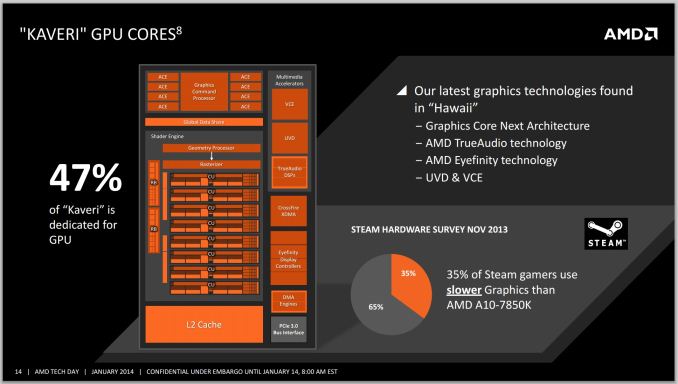
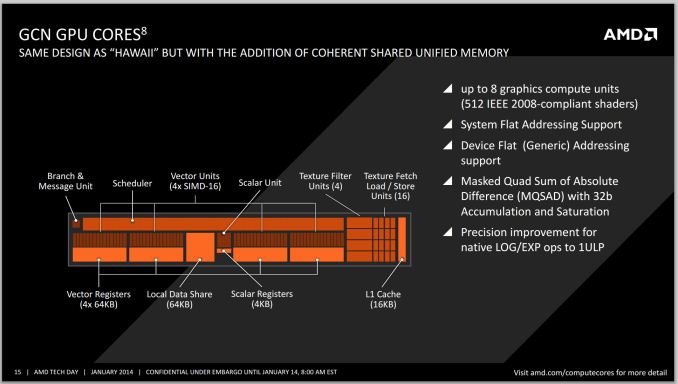
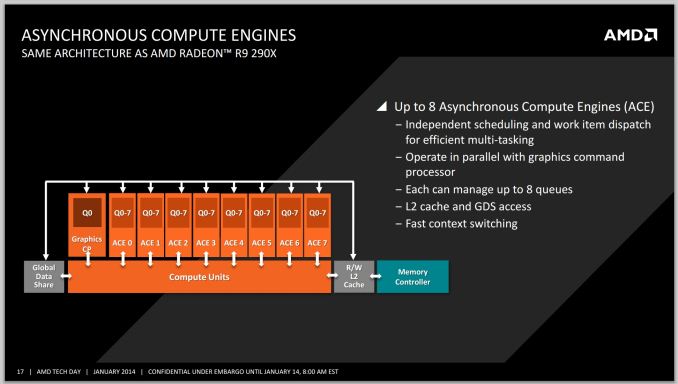
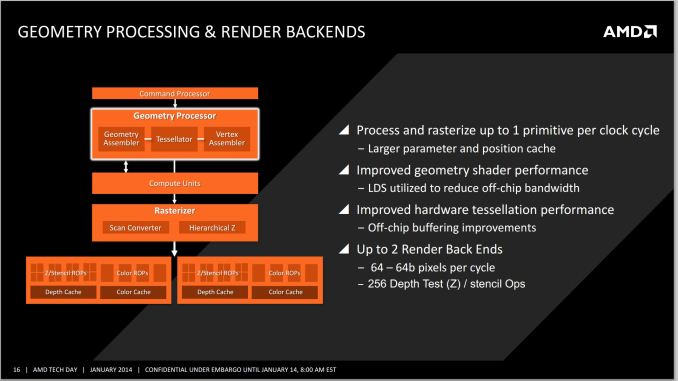
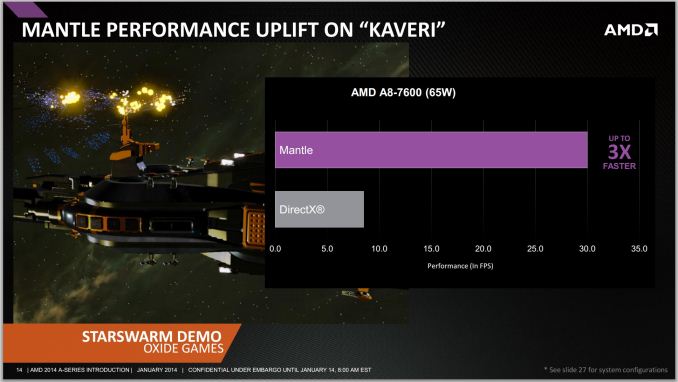
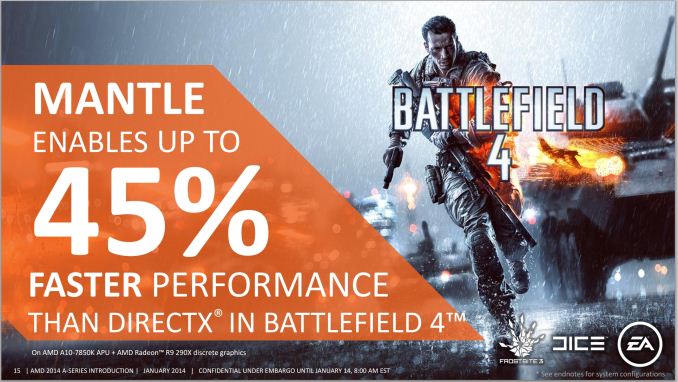
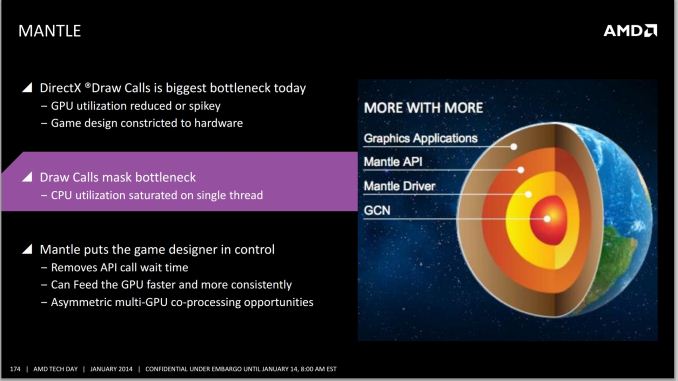
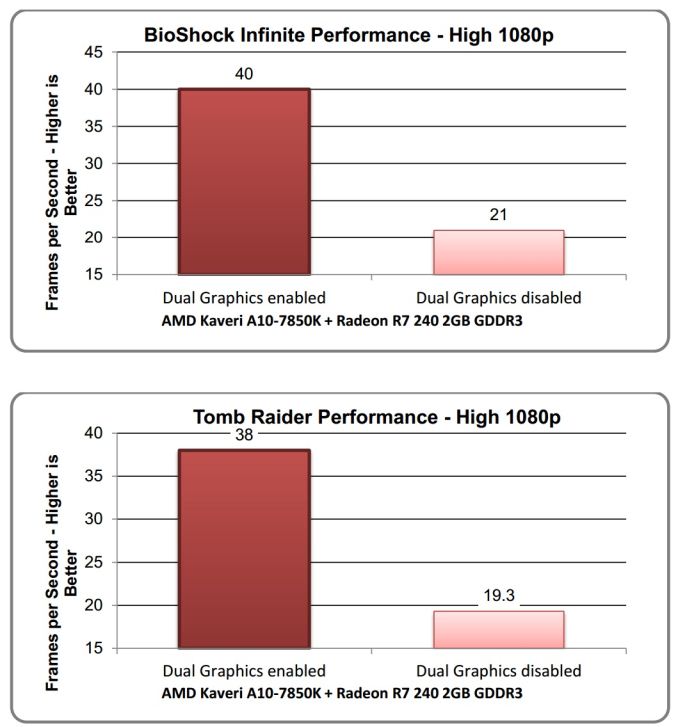
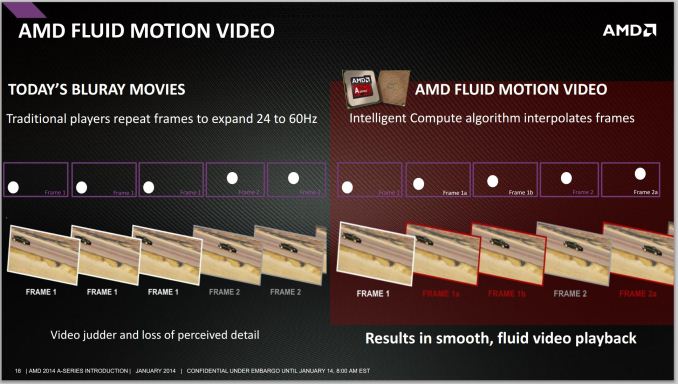








380 Comments
View All Comments
HanzNFranzen - Saturday, January 18, 2014 - link
Yea, 90% of people use Battlefield 4 90% of their time on the PC... You missed the question.keveazy - Saturday, January 18, 2014 - link
Doesn't matter.If you buy a PC, it's better to make sure it's solid and ready to handle applications that require strong physical cpu performance unless your still living the 90s dude.
My point is, AMD's highest end kaveri 7850k chip today is priced at the same range as Intel's low end i5 cpus. From here, you take your pic. If you wanna have a system that has worse graphics than ps4, go AMD.
kmi187 - Sunday, January 19, 2014 - link
If you've actually lived in the 90's you would know that cpu power was a lot more important back then than it is now. You didn't have hardware (gpu) acceleration for video and all that jazz to put less stress on the cpu.Also you do realize the PS4 runs on AMD hardware right?
medi02 - Tuesday, January 28, 2014 - link
What on earth are you talking about? What is a "solid PC"? One that fails at games?cryptik - Monday, March 30, 2015 - link
Today (30 Mar 2015) the AMD A8-7600 is the same price ($99) as the Intel Pentium G3460. The "lowest end" i5 CPU is $189. You're simply a liar who has no idea what he's talking about.vAngz - Sunday, January 26, 2014 - link
I believe you and others are missing the point. Can you play Battlefield 4 on medium settings @ 1080p using only the i5 4430, without using a discrete graphics card, and it still be playable above 30fps?Even though the chips are the same price (at most places), you can actually play BF4 using only the A10 7850K, which is not possible with the i5 4430. I bring this up mainly because you brought up BF4. When, rather if, Mantle is ever activated on BF4, things will change and we will see even better performance on the A10-7850K and later gen AMD APUs.
So, yes, you can get better performance out of the i5 4430, but you will need to spend more money on a discrete graphics card to use it for gaming, such as for BF4. I believe this what sets the AMD APUs apart from Intel offerings at the moment. We need to compare apples to apples.
I could be wrong, but I haven't seen anywhere in my research where anyone is getting that kind of performance out of i5 4430 without a discrete graphics card added into the mix. If you have a link on such info please share it with us. Thanks.
keveazy - Friday, February 7, 2014 - link
Your not getting it either. My mistake in my previous post is I didn't mention Battlefield 4 Multiplayer.That's where the APU will fail. It will fail in both the Cpu performance and Gpu performance. The APU is still the better choice at light gaming.
theduckofdeath - Wednesday, January 15, 2014 - link
I think he's referencing that processor simply because it's a pretty powerful, fairly low-priced processor for all of those who can live without all of those over-clocker tweaks...just4U - Tuesday, January 14, 2014 - link
You talk about 2500K performance and yet the majority of people I come across are not even working with that. The vast majority are still in the C2D/8800 like performance arena. What would be nice to see from some of these review sites in their performance analysis is if stuff like this makes sense to finally bite the bullet and get rid of the old dog..just4U - Tuesday, January 14, 2014 - link
Ian .. that's something I think you should look at btw.. we do get a fair number of lurkers /w some posting up questions like that about how it compares to the old warhorses their on. Hell even for those of us with old parts kicking around it's something to consider. Do we scrounge up some cheap ddr2 psu.. hand me down hard drives and pair it up for that box in front of the television or do we say no.. this makes far more sense and it's new.